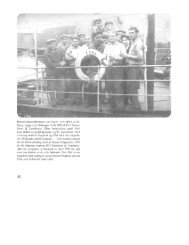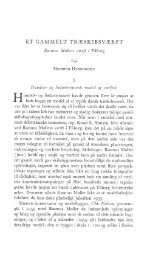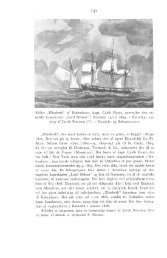Sømandens våde grav, s. 103-167 - Handels- og Søfartsmuseet
Sømandens våde grav, s. 103-167 - Handels- og Søfartsmuseet
Sømandens våde grav, s. 103-167 - Handels- og Søfartsmuseet
Create successful ePaper yourself
Turn your PDF publications into a flip-book with our unique Google optimized e-Paper software.
We do have a few details about burials at sea from heathen times, but we have<br />
many more from the Christian era. As long ago as the Middle Ages they took<br />
place in the same way as today with tokens of respect and Christian ritual, i.e.<br />
prayers, psalms, a funeral oration and the sprinkling of earth, before the body<br />
was east overboard wrapped in a sail or hammock, or perhaps laid in a coffin.<br />
A weight, such as coal, a stone or a cannonball, was attached to the body to make<br />
it sink, but the weight was often not heavy enough so that the body remained on<br />
the surface and even seemed to follow the ship. In warm seas the corpses were<br />
often eaten by sharks, mackerel or other sea animals. It was unpleasant to watch,<br />
but in principle no worse than worms and lizards eating the corpses in a <strong>grav</strong>eyard.<br />
Ancient heathen ideas have mingled with the Christian concepts. It was, for<br />
example, quite common to believe in death ships which fetched the buried and<br />
carried them to the kingdom ofthe dead, just as one still hears tales of phantom<br />
ships, the Flying Dutchman etc.Nobody was quite sure about the location of this<br />
kingdom of the dead. Here in Denmark it was believed that it was on Læsø, the<br />
island of the sea god Ægir (Hlér) and his wife Ran. In Brittany and England<br />
certain islands were considered to be death islands. Others referred to the<br />
fortunate islands in the ocean, God knows where. Later on, probably in the<br />
17th-18th century, English sailors, presumably rather much as a joke, »in<br />
vented« one or two maritime kingdoms of death. It was said that the bottom of<br />
the sea was ruled over by Davy Jones, an old pirate (in faet Davy was another<br />
name for the devil) who put all wicked sailors into his huge »locker«, which was<br />
then padlocked. It was supposed to be a kind of heil for lazy, untrustworthy,<br />
malingering sailors. To go to Davy's locker was a euphemism for dying. The<br />
counterpart to this was Fiddler's Green, which sounds like the name of a<br />
summer restaurant. It was paradise for the good, honest, conscientious sailors,<br />
who could enjoy themselves here as in sailor towns all over the world with rum,<br />
good food, tobacco, pretty girls, music and dancing. Even the legendary great<br />
ship »The Merry Dun of Dover« (and other names), could function as heaven.<br />
It was so big that the captain had to ride a horse to get around the deck, and the<br />
ship's boys s who climbed up on high came down again as old bearded sea d<strong>og</strong>s.<br />
There was an inn in every block in the rigging where the sailors not only enjoyed<br />
the same material pleasures as in Fiddler's Green, but also had the satisfaction<br />
of having their former tormentors put to work with the most menial jobs: the<br />
mates scrubbed the deck, the captains reefed the sails and the ship owners<br />
waited at table.<br />
It is, however, to be assumed that sailors who had been brought up in the<br />
Christian faith counted on going to heaven and not to heil. The reasoning was<br />
that the Lord could not bring Himself to punish the wretched and poor sailors<br />
165

















